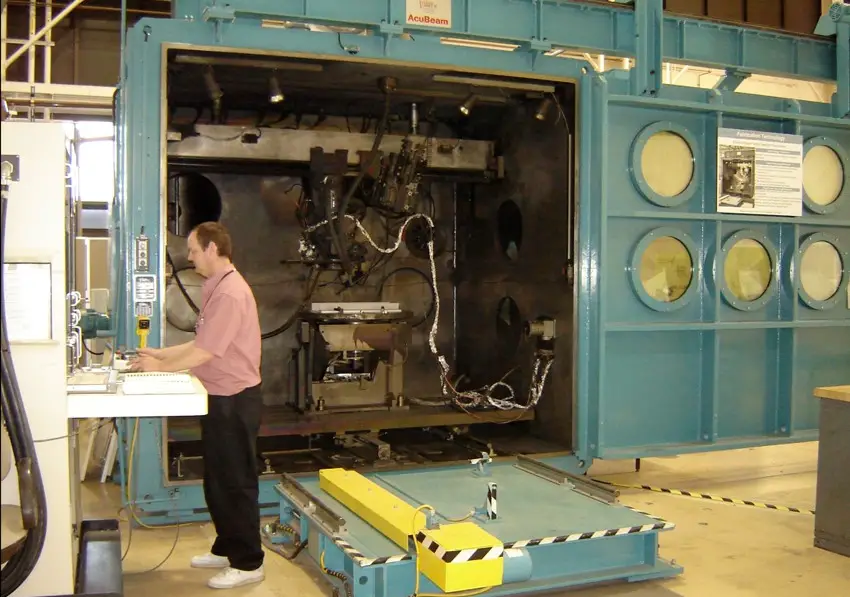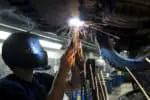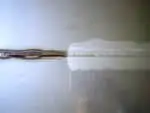Electron beam welding (EBW) is a metal welding technology that uses a beam of high energy electrons to heat the metal in a vacuum chamber. This melts the substance, forming a keyhole that solidifies as it unites with another component.
Electron beam welding is a type of liquid state welding. Liquid state welding refers to welding procedures in which the metal-to-metal connection is made into liquid.
Because it employs electron kinetic energy to fuse two metal work parts, this is also characterised as a novel welding technique.
Electron beam welding has various advantages like it can weld metals that are both similar and different. It also has a high metal joining rate and low operating costs due to the absence of filler material and flux.
And the drawback is that it requires a large initial investment, a high-level work is necessary and the size of the work components is restricted by the vacuum chamber.
Developed in 1958 by German physicist Karl-Heinz, it employs a high jet of electrons that impacts welding plates, converting their kinetic energy into heat energy.
Applications of Electron Beam Welding
Electron welding has several applications. I have mentioned a few of them below:
1.) It is employed in the welding and drilling of the workpiece.
2.) Electron beam welding is employed in a variety of sectors, including marine, automobile, aircraft, and manufacturing.
3.) It is also employed in the defence industry to make a variety of items.
4.) It is used to link two metals that are either comparable or different.
5.) Tungsten, ceramics, and other refractory materials are used for connecting.
6.) It is also employed in the medical field.
Let us understand what Electron Beam Welding is and its operation.
The operating principle of electron welding is the same as that of electron beam machining. With the aid of an electron beam, we may combine comparable or different metals.
Electron Beam Welding is a type of fusion welding in which the workpiece is heated by the impact of a focused electron beam with high kinetic energy on it.
In order to emit electrons, an electric gun or cathode is heated in a vacuum. High voltage (about 150 kV) accelerates electrons, and an electromagnetic coil converges them.
An electron beam’s location is controlled by a deflection coil. When a high-energy electron beam reaches a workpiece, the electrons’ kinetic energy is converted into heat energy, melting the material.
And this molten metal fills the gap between the pieces to be connected before solidifying and forming the weld connection.
Now let us read about the advantages and disadvantages of Electron beam welding.
Advantages of Electron Beam Welding
1.) Excellent strength- Electron beam welding may generate exceedingly smooth surfaces with no fractures or disbonds.
Welded products have mechanical qualities that are equal to those of the original materials from which they were manufactured, with a higher level of uniformity and precision than other types of welding.
2.) Good purity as there are no filler materials used- When compared to other types of welding, electron beam welding generates very clean welds with a lower percentage of contaminants such as oxides and slag.
In most cases, no filler materials are utilised during the EB welding process. The source material is melted to form the connection and therefore the assembly.
3.) Good for large scale processing- Electron beam welding generates extremely high surface temperatures while consuming relatively little energy.
As a result, the technique is particularly efficient for large-scale processing, such as automobile manufacture, and may save up to 40% of energy usage when compared to traditional methods.
4.) High welding speeds- Despite having a longer cycle time than laser beam welding, EBW can reach high welding rates of up to 30mm per second. The electron beam travels at such high speeds that the procedure can be completed in milliseconds.
5.) No gas contamination- There is no air gas contamination since electron beam welding is performed in a vacuum. As a result, the weld is as clean and as high-quality as feasible. EB welding is the greatest solution for pieces that require post-weld testing, such as x-raying.
6.) Joining dissimilar materials- EBW’s ability to weld materials with different melting points, such as copper to stainless steel, is one of its most significant benefits.
In terms of cost and performance, EB welding can also weld high-priced nickel alloys to relatively low-cost stainless steel.
7.) Cost effective- EBW is a cost-effective form of welding since it only requires a single pass of the electron beam, as opposed to TIG, MIG, and arc welding, which all require many passes of the heat source.
If the product design allows for it, the EBW process can also yield weight reductions, which can subsequently lead to further benefits such as reduced lead time and inventory costs.
Disadvantages of Electron Beam Welding
1.) Size constraints: The size of the welded components is restricted by the size of the vacuum chamber at your disposal.
2.) X-Rays and Radiation: Because x-rays and radiation are both present throughout the welding process, safety rules are quite stringent.
3.) Equipment: Because of the complexity of the technological equipment, skilled operators are required. If you’re beginning from scratch, you’ll need to invest in professional training and hire experienced competent welding engineers.
4.) Setup costs: The initial investment in equipment is high. To justify the expenditure, a corporation will require a big work-flow. Unless you have a high volume throughput over a lengthy period of time, it is typically more cost efficient to outsource your EBW requirements.
5.) A precise fit is required- Before welding, the joints should be thoroughly treated and joined to guarantee that the joint placement is precise and that the clearance is minimal and even.
6.) Skilled manpower is required- The technique cannot be completed by a semi-skilled individual, hence it requires a highly skilled worker who is familiar with the electron welding process.
Electron Beam Welding Components
The Electron Beam Welding Machine is made up of the following components:
1.) The Electron Gun: It is the nerve centre of electron beam welding. It is a cathode tube (negative pole) that creates electrons, accelerates them, and focuses them on a specific location.
This pistol is mostly constructed of tungsten or tantalum alloys. The cathode filament was heated to 2500 degrees Celsius for continuous electron emission.
2.) Anode: An anode is a positive pole located immediately after the electron cannon. Its primary job is to attract negative charges (in this case electrons), give them a route, and prevent them from deviating from it.
3.) Magnifying Glasses: Only convergent electrons may travel through a sequence of magnetic lenses. They absorb all low energy and divergent electrons and produce a powerful electron stream.
4.) High Voltage Power Supply: Power supplies are classified into two types: low voltage and high voltage.
-
-
- The low voltage range of thin welding is 5 to 30 kV.
- For thick welding, the high voltage range is 70 to 150 kV.
-
5.) Cathode Grid: The free electrons are created by the cathode grid. However, the voltage of free electrons created is relatively low eV. To accelerate these free electrons, they travel through a strong electric field created by the anode and emitter (Cathode).
6.) The Optical Monitoring System: The optical viewing system assists us in determining and establishing the point of action where the electron beam is impacted on the workpiece.
7.) Deflection Coil: The deflection coil is a form of magnetic lens that is used in cathode ray tubes. Scanning the electron beam over the screen is beneficial.
8.) Vacuum Chamber: There is no air in the vacuum chamber. This equipment does welding in a vacuum. The pressure given here is either below or equal to atmospheric pressure. It is sometimes referred to as the Braun tube or chamber.
9.) Workpiece: The workpiece is connected to the fittings. The workpiece might be made of metals that are comparable or different.
10.) Workpiece Holding Device: Fixtures are another name for workpiece holding devices. It is used to tightly hold the workpiece.
Steel castings, stainless steel, cast iron, and high tensile steel are used to make the fixtures.
FAQs-
Why is Electron Beam Welding performed in a vacuum?
A vacuum chamber is essential to prevent electron energy loss due to collisions with air molecules.
Equipment required for Electron Beam Welding to function?
An EBW setup includes the following essential pieces of equipment:
1.) An electron gun,
2.) Power source
3.) A vacuum chamber, and
4.) A workpiece holding device.
Conclusion
Electron Beam Welding is one of the unique ways of welding metals that has various advantages. However, you have to look up for its limitations also to make a well-informed decision before deciding to employ the EBW method.







